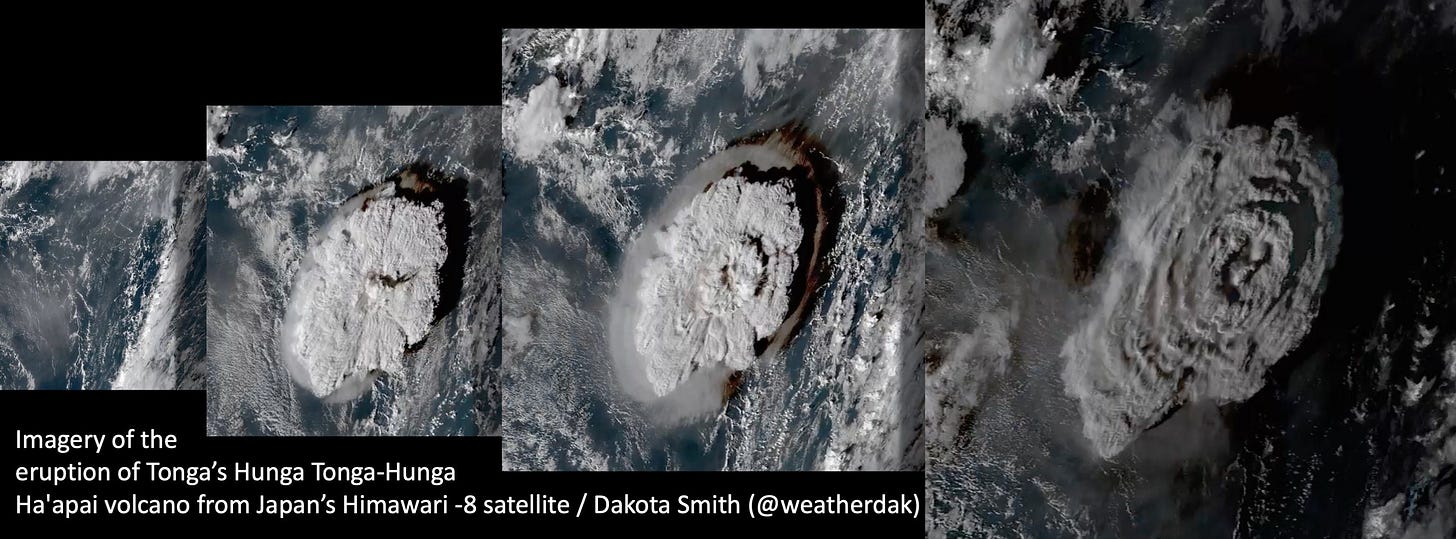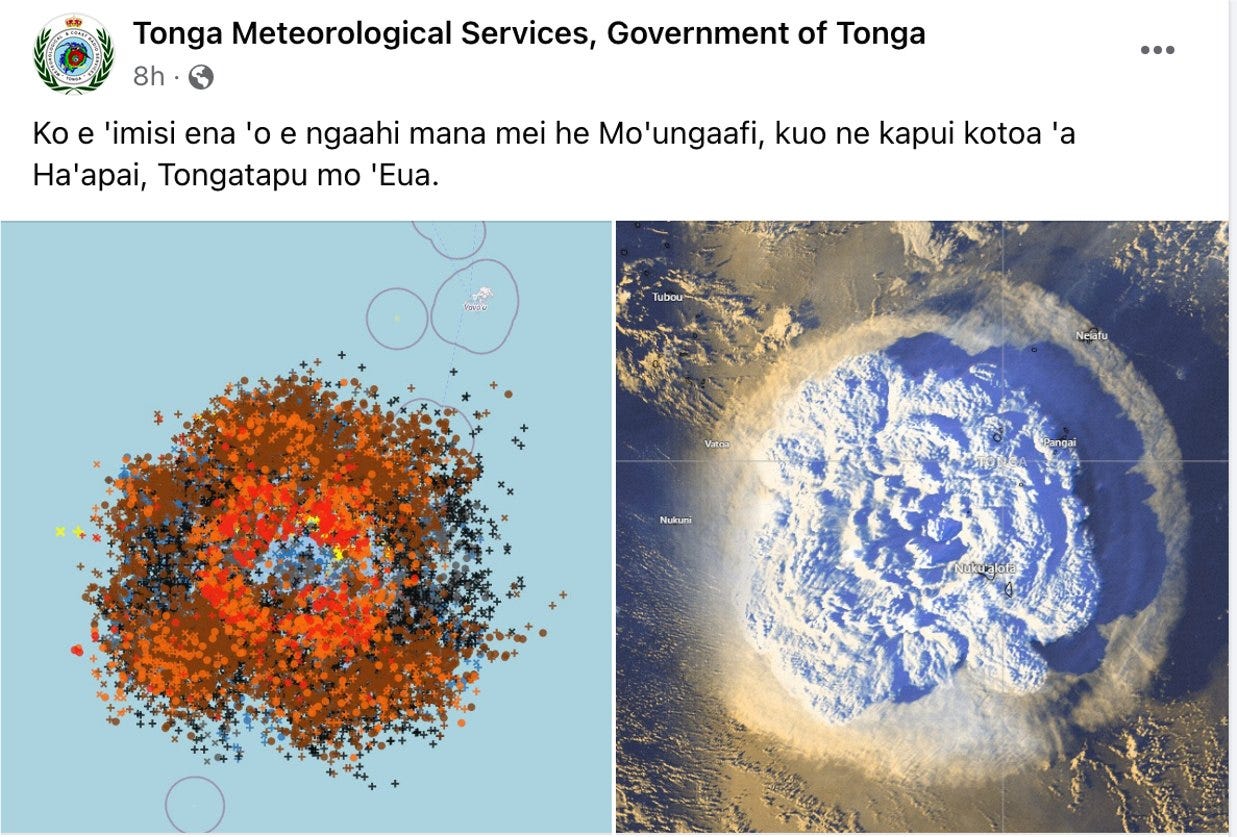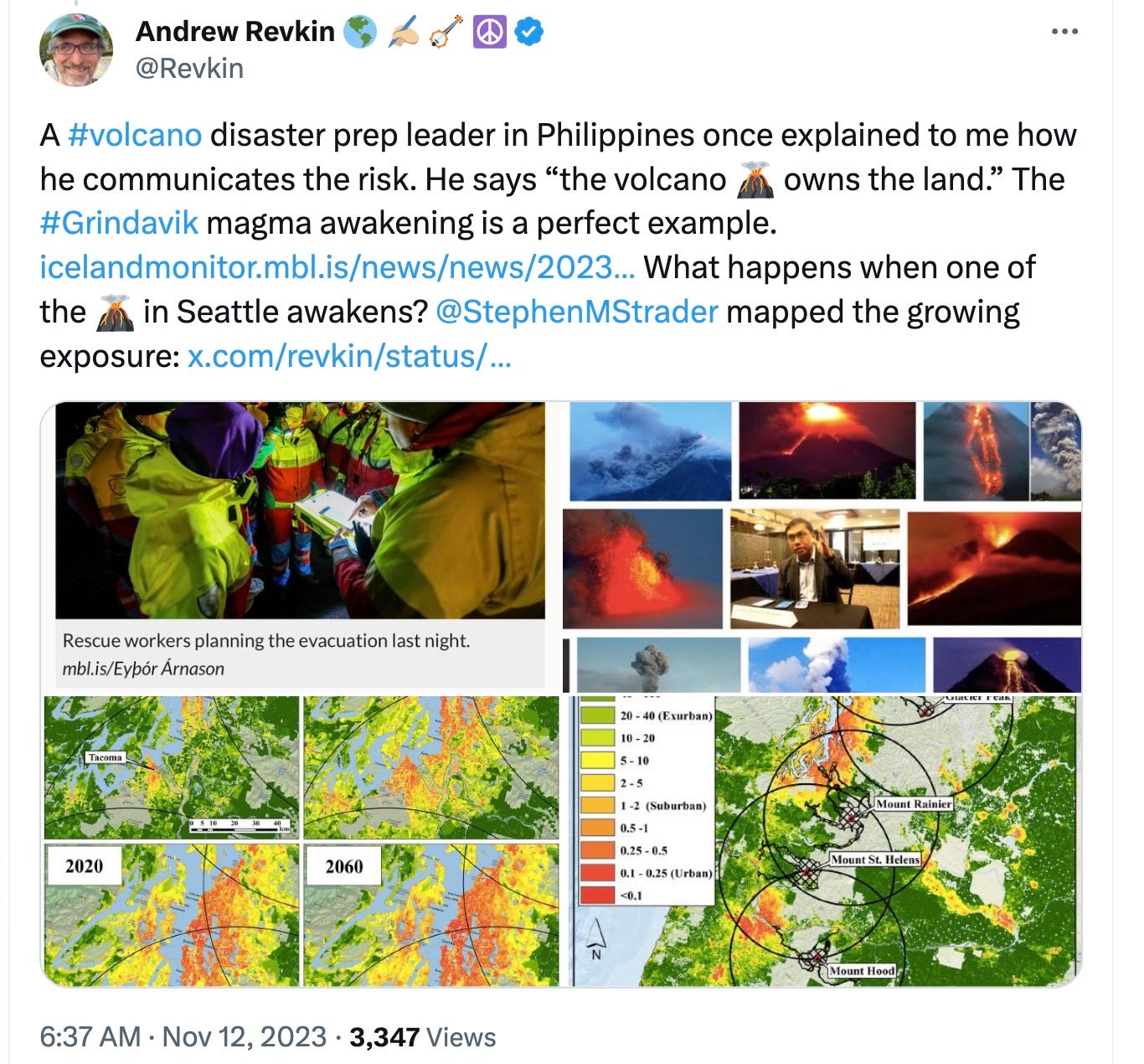A Tonga Eruption and Tsunami Show We Live on a Connected Planet in a Constant State of Creation, Destruction and Risk
Thanks for subscribing to my dispatches if you can (always free). I'll always try to be useful.
🌋 🌋 🌋
Tonga Meteorological Services on Facebook
Various updates | On January 14, the Hunga Tonga-Hunga Ha'apai volcano in Tonga explosively erupted. Massive shock waves were captured by Japanese and American satellites as nearby residents posted dramatic video of tsunami waves washing onto shores and Pacific-area tsunami warning centers issued, and then ended, wider warnings and advisories.
Research published in the journal Science in May confirmed initial studies finding the eruption produced the most potent explosive shock to the atmosphere in the modern era, as Jonathan Amos reported for the BBC.
Here's how things unfolded at the time:
On Twitter, Faka’iloatonga Taumoefolau (@sakakimoana) posted photos of ash-darkened skies and then tsunami waves washing the shore.
On Facebook, Filimoni Tuisatavu, who works at Fiji Broadcasting Corporation, posted truly astonishing closeup video of the bomb-like eruption. I’m seeking more information from him.
A still image from video posted by Filimoni Tuisatavu
[January 17 - On Monday, several reports of deaths emerged. The International Disasters Charter, a global coalition providing satellite imagery and analysis for relief efforts, published a damage report with a host of before-and-after images showing areas covered in ash or scoured by the tsunami.
One image set shows how the 700-acre islet where the volcano erupted has vanished beneath the sea.]
The full Disasters Charter damage report (International Charter Space and Major Disasters)
The tsunami was clearly violent along the closest coasts, as tweeted video showed.
Thankfully local and global tsunami warning systems have advanced enormously since the terrible Boxing Day great earthquake and tsunami swept the Indian Ocean. I reported in depth on that calamity.
After reading my initial post, Jane Wells, also a Bulletin writer, wrote this comment describing California's automated alert system warning of 1- to 3-foot waves arriving from the South Pacific event:
A photographer in Santa Cruz, California, Tim Cattera (@timcatteraphoto), posted a series of videos showing the tsunami's powerful surge in the harbor thousands of miles from the source.
It's worth stepping back to marvel at the astounding capacity our species has developed to witness and share - at scales from close up to planetary, and almost moment by moment - the jolts of the dynamic ocean-wrapped orb we evolved on.
Dakota Smith, a masterful tracker and disseminator of satellite imagery at Colorado State University's Cooperative Institute for Research in the Atmosphere, was all over the eruption on Twitter (@weatherdak). He then knitted together a batch of Japanese and American satellite imagery showing the propagating shock waves and towering ash clouds and posted the video on his Okay Let's Science YouTube account.
We tend to pay attention to volcanism only during such dramatic moments, but it's worth visiting the Smithsonian Institution's Global Volcanism Program website to be reminded that there are dozens of continuing eruptions at any moment. As their latest listing says, "Overall, 46 volcanoes were in continuing eruption status as of 9 December 2021."
The planet is constantly in a state of creation and recycling itself, as my friend and former New York Times colleague William J. Broad eloquently wrote in our team coverage following the great Indian Ocean tsunami of December 2004.
Without those dynamics we wouldn't be here.
But because of them, communities in many parts of the world need to maintain a state of vigilance and responsiveness to limit human losses when the worst happens.
From Tonga to Iceland to Seattle, “the volcano owns the land”
On a panel I ran on volcano preparedness at a 2018 Mexico City conference on Understanding Risk, I asked Renato Solidum, a top volcano and disaster scientist in the Philippines, how he engages communities in eruption danger zones.
His mantra? "The volcano owns the land."
Inserted, 11/12/23 - During that meeting I did a Twitter thread on the importance of spreading eruption awareness to places like Seattle where development has created enornous - and still growing - exposure to this unstoppable hazard. I referenced it on X today as Iceland was evacuating a fishing town of 4,000 ahead of a looming eruption.
There's much more on this theme from that conference in this post from a World Bank team: "Communicating volcanic risk: lava, eruptions and uncertainty."
Given all of this, I like the pitch to launch a satellite tuned to the needs of volcano science and warning systems put forward by Erik Klemetti, a volcanologist blogging at Discover magazine who's also a vital resource on Twitter (@eruptionsblog).
"Satellites might be constantly watching the planet, but we don't have a dedicated orbital volcano observatory that could save countless lives and dollars," he noted, estimating the cost at $300-500 million. "That still sounds like a lot," he wrote. "But if we consider the cost of recent volcanic disasters, like the 1991 eruption of Pinatubo ($800 million), Eyjafjallajokull in 2010 ($4 billion) or the 2018 Kilauea eruption ($800 million), you can see how quickly the damage adds up."
Oceans as connections
I'll add a coda here - a tweeted gift of hope, prayer and history from Sara Kahanamoku (@sara_kahanamoku), a doctoral researcher at the University of California, Berkeley, focused on historical marine ecology and equity in science:
"Praying for Tonga, and Fiji, and Samoa, and all affected by the volcano + tsunami. All of us across Moananuiākea are seeing changes in the ocean and it’s a reminder that our sea of islands remains connected. What happens to one of us affects us all. E ola kākou."
Here's my reply:
"Moananuiākea is a far better (and more just) name for what most maps call Oceania. Best hopes to all in harm's way around Tonga and across the Pacific from the pulse of energy released by the dynamic earth beneath Tonga."
Here's more on Moananuiākea - the original name for "the largest feature on earth named by humans other than the earth itself."
Support Sustain What
Any new column needs the help of existing readers. Tell friends what I'm up to by sending an email here or forwarding this introductory post.
Thanks for commenting below or on Facebook.
Subscribe here free of charge if you haven't already.
Send me feedback (including corrections!), tips, ideas here.
Find my social media accounts, books and music in a click here. And please share Sustain What with solution-focused friends and colleagues!











